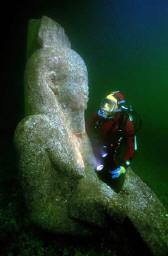A stunning new exhibition has opened in Turin, showcasing gold, statues, jewels and lost treasures from ancient Egyptian cities lost beneath the waters of the Nile.
'Egypt: Sunken Treasures' hosts over 500 artefacts pulled from the riverbed and spanning a period of 1,500 years, from the 7th century BC to the 8th century AD.
The items were rescued from the lost cities of Herakleion and Canopus and submerged sections of Alexandria, by one of the world's leading marine archaeologists, Franck Goddio of France, over a period of 15 years.
All three sites started a gradual descent into the Nile around 2000 years ago and are now submerged by around six metres of water.
The items on show map out major developments in Egyptian history, from its early centuries of greatness, through contact with Byzantine, Greek and Roman civilizations, to the Arab conquest in the 7th century.
The exhibition boasts several star attractions, starting with a massive obelisk dating to the 2nd century BC, which bears an inscription linking it to Ptolemy VIII. The stone, which had been shattered into many pieces when discovered, is six metres tall and weighs in at 16 tonnes.
Three massive granite statues, ranging from 4.9 to 5.4 metres in height are also expected to pull crowds.
The first two show a royal couple from the time of the Ptolemeic Dynasty during the 300 years before Christ's birth, while the third statue represents the god Hapy, a deification of the Nile's annual flood.
But the exhibition not only boasts large-scale attractions, it also features small and delicate items, such as gold coins, a wedding ring engraved with a New Testament inscription and various curiosities, such as a group of small bronze fishhooks.
The staging of the exhibition has excited considerable interest. The set was designed by award-winning US director and theatre artist Robert Wilson, while Laurie Anderson, an experimental musician, composed the exhibit's 'soundtrack'.
The two have sought to recreate the sounds, light and sensations of underwater depths, with a different ambience in each of the exhibit's ten sections.
The first and final room are each dedicated to a single statue, the former awash with light, the latter reached after passing through a nearly-black tunnel.
The various environments between the two recreate an 'underwater forest', the sensation of crashing waves and a field of coral, among other things.
The exhibition, which runs until May 31, is on show at the Venaria Reale. Considered Italy's answer to Versailles, this former royal palace complex reopened in 2007 following years of restoration.










